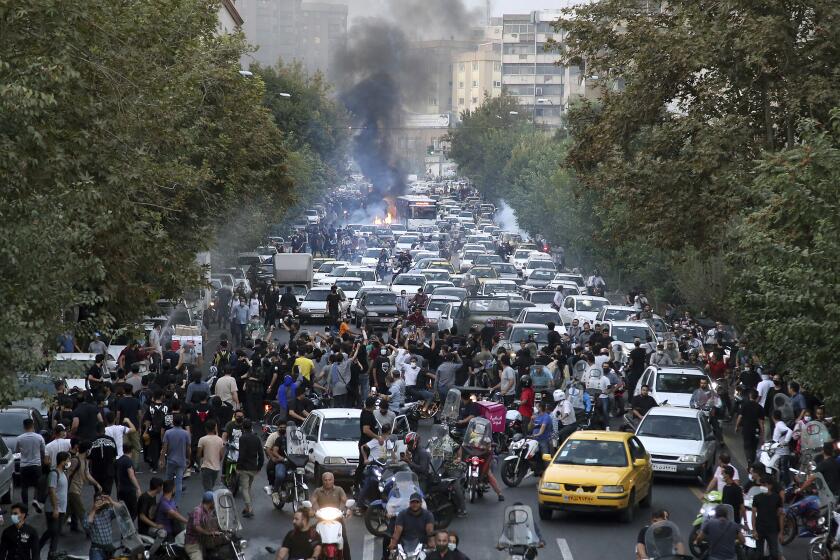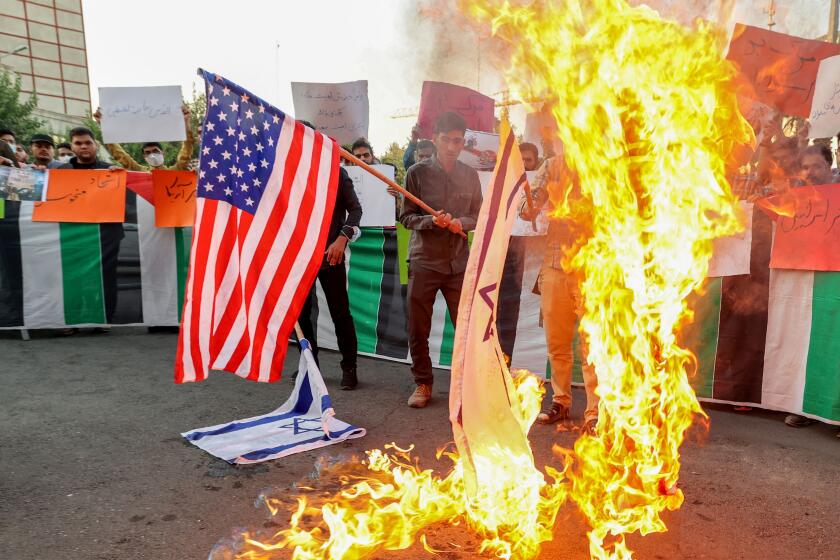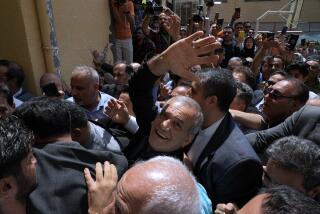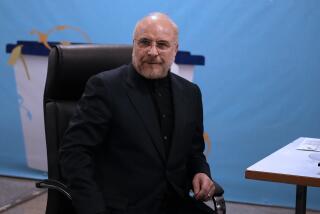Op-Ed: Iran has a long history of protests. This time it’s different
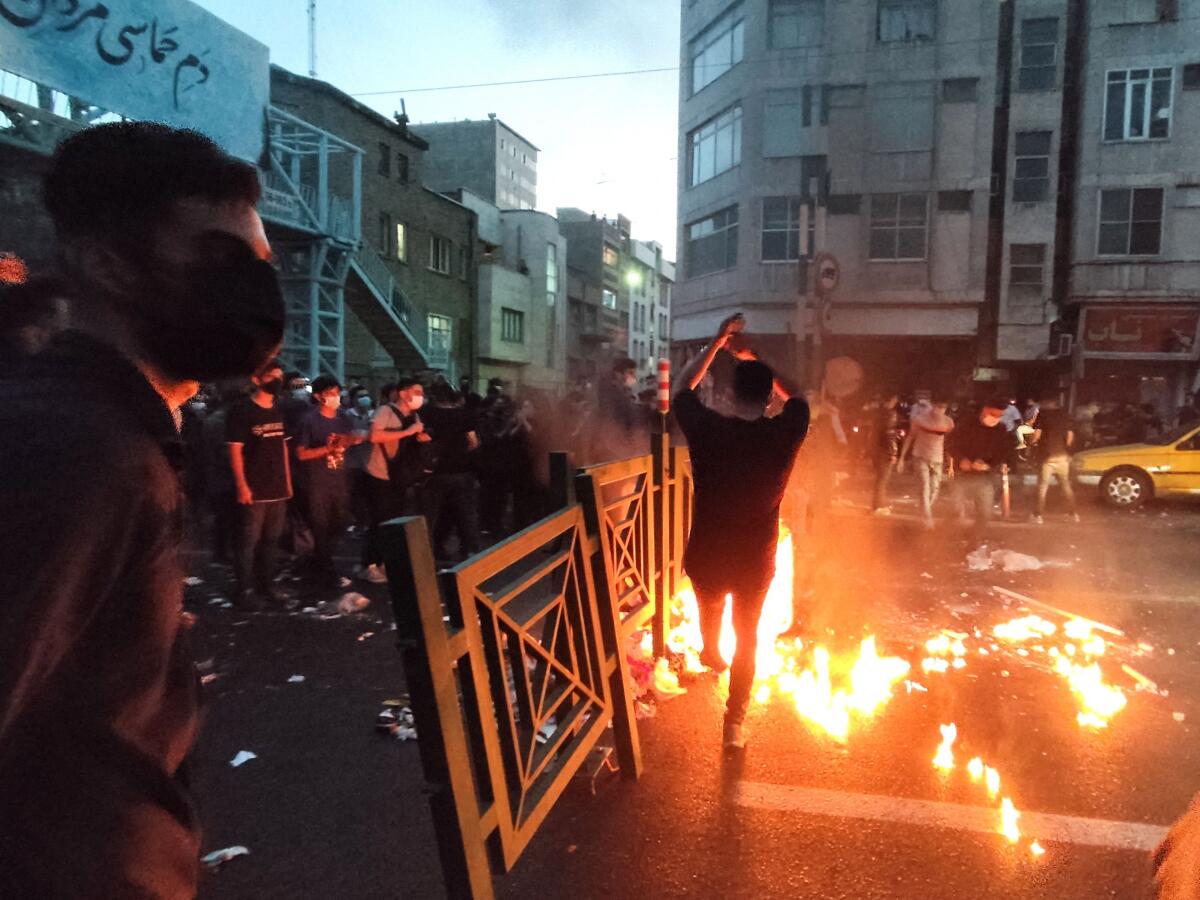
- Share via
Three weeks in, Iran’s protests show no signs of stopping. Sparked by the death of a young Kurdish Iranian woman named Mahsa Zhina Amini after being detained by the morality police, rallies have spread from the towns of Kurdistan to the rest of the country.
The protests are unprecedented in scale and unity: Iranians from different ethnic and regional backgrounds, nonreligious and religious alike, have taken part, defying government threats that rebellion could lead to chaos. And they differ dramatically from past protests that have shaken the country’s leadership.
Authorities have tried to crush the demonstrations with batons, tear gas and bullets. Dozens, and possibly many more, have been killed and many more arrested. But the movement continues. Small groups of protesters move from place to place erecting temporary barricades, yelling out, “Death to the Dictator!” and throwing rocks at cops who try to stop them.
Students at many universities have gone on strike, holding sit-ins and walkouts that have been violently dispersed. Acts of civil disobedience have even spread to high schools, where thousands of girls have defiantly pulled off their mandatory veils and shouted down administrators trying to stop them. Videos show schoolgirls replacing images of Supreme Leader Ali Khamenei in their classrooms with the slogan of the movement: Woman, Life, Freedom.
In Islam, faith is a choice. What I see on Iran’s streets today — mandatory hijab being maintained at gunpoint — could not be further from what the government claims to represent.
The protests’ strength is that they are unorganized and leaderless — a grass-roots expression of discontent. They are led overwhelmingly by young women. Many of those detained are teenagers; the movement is being led by a generation taking part in political dissent for the first time.
The last time Iran saw protests on this scale was after the 2009 elections. Mir-Hossein Mousavi ran against incumbent Mahmoud Ahmadinejad in a closely contested vote after years of reformist activism to expand social and political freedom and democratize Iran’s tightly controlled elections, even as the unelected Khamenei, in power since 1989, retained final say.
Enthusiasm and expectations of change were high. I volunteered with Mousavi’s campaign, joining youthful crowds playing music in buoyant get-out-the-vote rallies. Mousavi’s message of freedom, social equality, and expanded rights for ethnic minorities resonated; many believed he stood a good chance of beating Ahmadinejad, known to be Khamenei’s favorite.
These hopes were soon dashed. Election results were released showing an Ahmadinejad victory. But they appeared riddled with errors. Experts soon began raising alarms about widespread vote rigging.
Protests broke out across the country, known as the Green Movement, after Mousavi’s campaign color. Millions demanding transparency joined marches under the slogan: “Where is my vote?” Shortly afterward, authorities cracked down. Security forces opened fire on crowds, killing dozens and detaining thousands more.
The protests eventually died down. The government put opposition candidates under house arrest, where they remain today, cutting the movement’s head off.
The 116-year-old Persian Constitutional Revolution spawned the country’s long tradition of protest, seen in recent demonstrations over cuts to food subsidies.
In 2009, Iranians were driven to the streets by hope. By casting votes, they believed that change was possible through the elections. Today, in contrast, it is desperation and fury driving Iranians to the streets.
Iran has changed dramatically over the last decade. The imposition of U.S. sanctions since 2011 has undermined the economy, undercut the rial’s value, impoverished ordinary Iranians and cut them off from the rest of the world.
In 2013, millions defied repression to vote for reformist President Hassan Rouhani, who carried the Green Movement’s legacy. But hopes evaporated when President Donald Trump tore up the historic 2015 Iran nuclear agreement and imposed new sanctions. This caused a major backlash against the reformists, who had argued for years that the West could be trusted.
Yearly protests have rocked Iran over the last five years, centered on economic inequality and the impact of a growing environmental crisis. Brutal repression against these protests has revealed a regime increasingly unwilling to bear any criticism and presidents seemingly unable to protect citizens from the security forces.
Iranians’ faith in the political system reached a nadir in last year’s presidential elections, when authorities disqualified any candidate who could challenge Ebrahim Raisi, a conservative cleric with a sordid human rights record who had overwhelmingly lost the previous election — but was Khamenei’s preferred candidate.
While in 2009 vote-rigging happened behind the scenes, the 2021 election rigging occurred in the open. In disgust, most eligible Iranians refused to cast a ballot.
Khamenei achieved his dream — almost complete political power. But in the process, he has created his worst nightmare. By undermining elections, he removed one of the few avenues left for Iranians to express discontent. Because he has monopolized politics, the only way people can now imagine change is if he goes. And since he has repressed civil society for decades, few viable organized alternatives exist.
The regime has for years warned people that protest could lead to chaos, pointing to neighboring states like Iraq, Afghanistan and Syria torn apart by foreign intervention. But in recent weeks, the wall of fear has been broken. A new generation is taking the lead. Their slogans have expanded from being focused on women’s rights to include wider systemic change: “Death to the Oppressor, whether a Shah (king) or a Rahbar (religious leader).”
With protests spreading from Amini’s Kurdish hometown to Azeri Turkish cities, the Persian heartland, and Arab and Baluchi towns hundreds of miles away, it is clear this vision resonates across Iran’s diverse mosaic.
Iranians are deciding their own fate. But it is crucial that the international community support them, including by lifting sanctions that have had a corrosive effect on Iranian civil society. The Biden administration wisely relaxed U.S. sanctions that blocked Iranians’ access to communication tools. He must continue to do more in that direction, including easing visa, financial and educational interchange restrictions that limit Iranians’ access to the outside world.
The Iranian government may crack down on the crowds and the dissidents. But the scope of change the public is imagining has significantly shifted since 2009.
Even if the regime puts out the flames of rebellion today, the embers will continue to smolder.
Alex Shams is a PhD student of anthropology at the University of Chicago. His research focuses on politics and religion in the contemporary Middle East.
More to Read
A cure for the common opinion
Get thought-provoking perspectives with our weekly newsletter.
You may occasionally receive promotional content from the Los Angeles Times.
